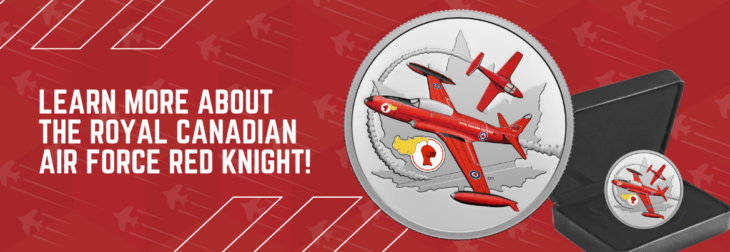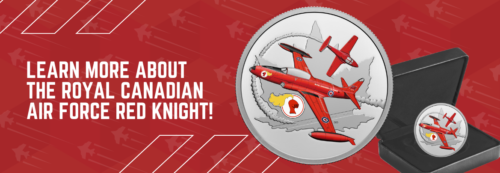Last updated on May 2nd, 2024 at 03:31 pm
Last Updated on May 2, 2024 Posted by Colonial Acres Coins
If you are interested in either Canadian coins or aerobatics, you are probably already familiar with the commemorative coins celebrating the Snowbirds and the Golden Hawks. The Red Knight was an air display team that predated the former and outlasted the latter, but since the cancellation of the program in 1970, fewer Canadians are familiar with it. In 2022, the Royal Canadian Mint released a pure silver $30 coin commemorating the Red Knight for the first time. It is likely to be popular with both aviation enthusiasts and those who appreciate Canadian coins.
Origins
The Canadian International Air Show is the premiere event of its kind in Canada. In 1958, a Royal Canadian Air Force flight instructor named Roy Windover attended the show where an American exchange pilot gave a solo aerobatics display. What bothered Windover was that the American was flying an RCAF jet.
Having appealed to his superiors and gained permission, Windover devised and practiced a solo air routine of his own. He flew a Canadair CT-133 Silver Star that was painted bright red to make it easier to see. The act became known as the Red Knight after Baron Manfred von Richthofen, a German fighter pilot in World War I known alternatively as the Red Knight or the Red Baron.
Windover only gained permission to perform his act at three shows. After that, the plane was restored to its original colour and training duties. However, the following year marked the RCAF’s 35th anniversary. One of the organizers of the celebration requested the return of the Red Knight. Though scheduled to end again, the Red Knight program was extended due to its enormous popularity.
In a little over a decade, the Red Knight gave over 600 performances across Canada and the United States. At the time, it was the longest-running Canadian aerobatics display, and today, it is exceeded only by the Snowbirds, making it a great addition to commemorative Canadian coins for sale.
Team Members
Originally, the Red Knight team consisted of one pilot and one plane. A full-time crew chief was added in 1960. In case of unforeseen circumstances, such as illness or mechanical problems, the Red Knight team expanded to include a spare plane and an alternate pilot in 1961. This would be the basic format of the team until the cancellation of the program. The alternate pilot would study the routine for a year, at which time the main pilot would step down and the alternate would become the new Red Knight. Over the course of the program, 17 pilots would participate.
In 1968, due to a fatal crash and a lack of suitable T-33 aircraft for replacements, the Red Knight switched to a Golden Centennaire Tutor painted the iconic red shade.
Coin Design
Those wishing to buy this Canadian coin should be impressed by the detailed design on the reverse of the Red Knight coin. It features the two models of planes flown as part of the display. The T-33, with the tanks on the tips of its wings, appears in the foreground. The Tutor appears in the background having executed an impressive aerial maneuver. Both planes appear bright red.
The Red Knight’s insignia, a red helmet in profile against a round white shield, is visible on the nose of the T-33 while also appearing more prominently as part of the background. The emblem also appears as a laser-engraved repeating motif on the obverse of the coin in the background behind Queen Elizabeth II’s portrait.
On the wings and fuselage of the T-33 is the maple leaf design of the RCAF Roundel (the bullseye emblem). This image, in the pre-1965 style, also appears as a backdrop behind the two planes.
Historic Canadian Coins
For over 10 years, the Red Knight display entertained thousands of people and inspired hundreds of future pilots. Visit a Canadian coin shop like Colonial Acres to purchase this coin celebrating the Red Knight’s legacy or see many more coins that feature historic events, people, places and the beauty of Canada.




